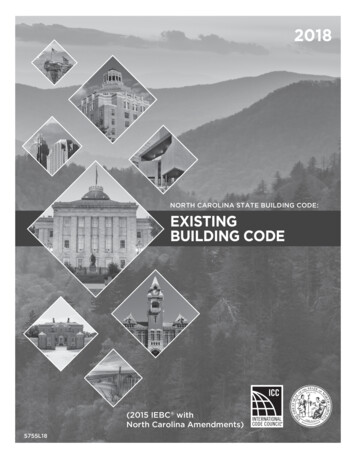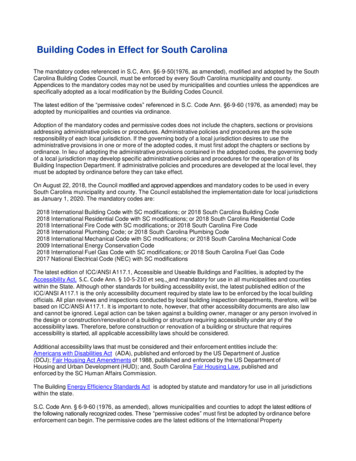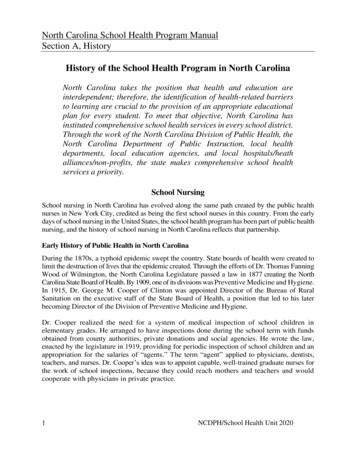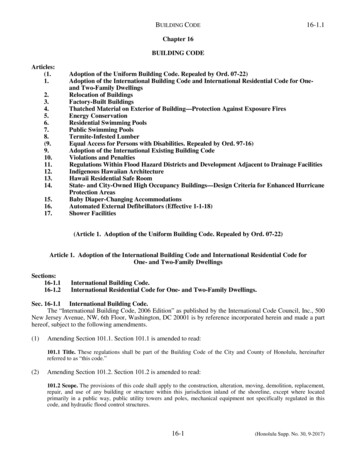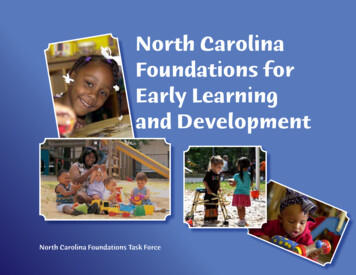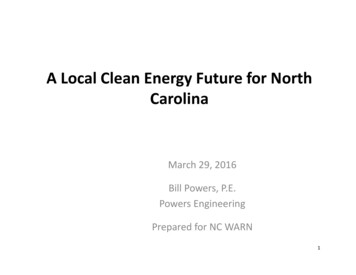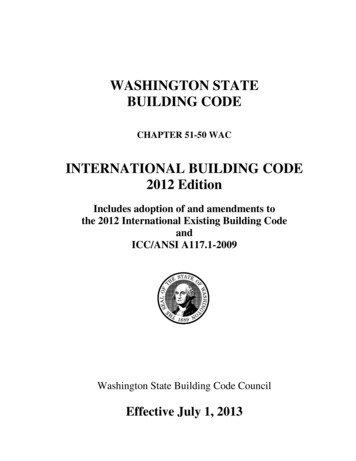
Transcription
2018NORTH CAROLINA STATE BUILDING CODE:BUILDING CODE(2015 IBC withNorth Carolina Amendments)5701L18
2018 North Carolina Building CodeFirst Printing: May 2018ISBN: 978-1-60983-822-5COPYRIGHT 2018byINTERNATIONAL CODE COUNCIL, INC.ALL RIGHTS RESERVED. This 2018 North Carolina Building Code contains substantial copyrighted material from the 2015International Building Code , third printing, which is a copyrighted work owned by the International Code Council, Inc. Without advance written permission from the copyright owner, no part of this book may be reproduced, distributed or transmitted inany form or by any means, including, without limitation, electronic, optical or mechanical means (by way of example, and notlimitation, photocopying, or recording by or in an information storage retrieval system). For information on use rights and permissions, please contact: ICC Publications, 4051 Flossmoor Road, Country Club Hills, IL 60478. Phone 1-888-ICC-SAFE (4227233).Trademarks: “International Code Council,” the “International Code Council” logo, “ICC,” the “ICC” logo, “International Building Code,” “IBC” and other names and trademarks appearing in this book are trademarks of the International Code Council, Inc.,and/or its licensors (as applicable), and may not be used without permission.Cover photo courtesy of Jeffery Clare.PRINTED IN THE U.S.A.T022613
NORTH CAROLINA STATE BUILDING CODE COUNCILDECEMBER 12, 2017www.ncbuildingcodes.comCHAIRVICE CHAIRCharles Conner, RA — 22(Architect)Hager Smith Design300 South Dawson StreetRaleigh, NC 27601919-838-5104Robbie Davis — 21(General Contractor)Turn-Key Contractors5998 Dortches BoulevardRocky Mount, NC 27804252-977-6680Daniel Priest, RA — 22(Architect)Priest ArchitecturePO Box 5295Charlotte, NC 28299704-379-1810Gary Embler — 23(Home Builder)Niblock Homes759 Concord Pkwy N, Ste. 20Concord, NC 28057704-361-7720Bridget Herring — 23(Public Representative)Energy Program CoordinatorPO Box 7148Asheville, NC 28802828-484-4852Tony Sears — 22(Municipal Representative)KinstonPO Drawer 339Kinston, NC 28502252-939-3111Ralph Euchner — 19(Gas Industry)PSNC EnergyPO Box 1398Gastonia, NC 28053704-810-3331Steve Knight, PE — 21(Structural Engineer)Steve L. Knight, PE1507 Mount Vernon Ave.Statesville, NC 28677704-878-2996Leon Skinner — 21(Building Inspector)Raleigh1 Exchange Plaza, Ste. 500Raleigh, NC 27601919-996-2455Keith Hamilton — 19(Mechanical Contractor)Element Service Group7414 Almaden WayCary, NC 27518919-926-1475Frankie Meads — 22(County Representative)Albemarle Home Builders200 Bayshore DriveElizabeth City, NC 27909252-330-2423David Smith — 22(Coastal Contractor)D. Smith Builder905 Saltwood LaneWilmington, NC 28411910-681-0394Wayne Hamilton — 21(Fire Services)Buncombe County270 Upper Herron Cove RoadWeaverville, NC 28787828-658-3911Robert Morrow — 19(Electrical Contractor)Electrical ContractorPO Box 1121Pilot Mountain, NC 27041336-420-7231Eric Tjalma, RA — 23(State Agency)State Construction301 North Wilmington St.Raleigh, NC 27601919-807-4097Keith Rogers, PE — 21(Mechanical Engineer)Bass, Nixon and Kennedy6310 Chapel Hill Road, Ste. 250Raleigh, NC 27612919-851-4422Wade White, PE — 19(Electrical Engineer)Brite Engineering2001 Old Westfield RoadPilot Mountain, NC 27041336-351-37812018 NORTH CAROLINA BUILDING CODEiii
NORTH CAROLINADEPARTMENT OF INSURANCEwww.ncdoi.com/osfm919-647-0000By Statute, the Commissioner of Insurance has general supervision of the administration and enforcement of the North CarolinaState Building Code and the Engineering Division serves as the Staff for the Building Code Council. Officials of the Departmentof Insurance are:MIKE CAUSEYCommissionerBRIAN TAYLORSenior Deputy CommissionerCLIFF ISAAC, PEDeputy CommissionerBARRY GUPTON, PEChief Code ConsultantCARL MARTIN, RABuilding Code ConsultantCOMMITTEES OF THE COUNCILDECEMBER 12, 2017ivADMINISTRATIONENERGYMECHANICALRobbie Davis — ChairDaniel Priest, RA - Vice ChairRalph EuchnerWayne HamiltonSteve Knight, PEKeith Rogers, PELeon SkinnerDavid SmithWade White, PERalph Euchner — ChairCharles Conner, RASteve Knight, PEFrankie MeadsBridget HerringTony SearsDavid SmithEric Tjalma, RAKeith Rogers, PE — ChairRalph EuchnerKeith HamiltonBridget HerringRobert MorrowDavid SmithEric Tjalma, RAWade White, PEBUILDINGEXISTING BUILDINGRESIDENTIALDaniel Priest, RA — ChairCharles Conner, RAWayne HamiltonSteve Knight, PETony SearsLeon SkinnerEric Tjalma, RALeon Skinner — ChairKeith HamiltonWayne HamiltonSteve Knight, PERobert MorrowDaniel Priest, RAWade White, PEDavid Smith — ChairCharles Conner, RARalph EuchnerKeith HamiltonSteve Knight, PEFrankie MeadsRobert MorrowLeon SkinnerELECTRICALFIRE PREVENTIONSTRUCTURALWade White, PE — ChairRalph EuchnerBridget HerringRobert MorrowDaniel Priest, RAKeith Rogers, PEWayne Hamilton — ChairCharles Conner, RARalph EuchnerDaniel Priest, RALeon SkinnerWade White, PESteve Knight, PE — ChairFrankie MeadsDaniel Priest, RAKeith Rogers, PETony SearsLeon SkinnerEric Tjalma, RA2018 NORTH CAROLINA BUILDING CODE
ACKNOWLEDGEMENTSNorth Carolina Building Code CouncilBuilding Code Chapters 1-15 Ad-Hoc CommitteeCHAIRDan AustinNC Department of InsuranceAlbemarle BuildingRaleigh, NC 27603Betsy BaileyCarolinas Association of General Contractors6115 Park South Drive, Suite 350Charlotte, NC 28210Robbie DavisTurn-Key Contractors5998 Dortches BoulevardRocky Mount, NC 27804Wayne HamiltonAsheville Fire ServicePO Box 7148Asheville, NC 28802Jeff JohnsonJeff Johnson Consulting, Inc.225 Red Hill LaneNew Hill, NC 27562Carl P. MartinNC Department of InsuranceAlbemarle BuildingRaleigh, NC 27603Robbie M. Pate (Retired)3620 Joyner Rd.Elm City, NC 27822Daniel PriestPriest ArchitecturePO Box 5295Charlotte, NC 28299Bryan RobinsonCity of RaleighOne Exchange PlazaRaleigh, NC 27602Dan TingenTingen Construction Company, Inc.8411-101 Garvey DriveRaleigh, NC 27616North Carolina Building Code CouncilBuilding Code Chapters 16-36 Ad-Hoc CommitteeMark G. BaileyNC Department of InsuranceAlbemarle BuildingRaleigh, NC 27603Michael Huslage, AIABobbitt A & E, PLLC600 Germantown RoadRaleigh, NC 27607William Murchison, PENC Department of Administration, SCO301 North Wilmington StreetRaleigh, NC 27601Frank Park, MS, PE, CFMGuilford County Planning & Development400 West Market StreetGreensboro, NC 27402Steve Knight, PENC Building Code Council1507 Mount Vernon Ave.Statesville, NC 28677Bob Ruffner, Jr.Clancy and Theys Construction CompanyP.O. Box 4189Wilmington, NC 28406Jeff Morrison, PEStroud, Pence & Associates415 Hillsborough Street, Suite 101Raleigh, NC 27603Dennis E. Williams, AIAWilliams Design, Architects & Planners, PA126 E Sycamore StreetLincolnton, NC 280922018 NORTH CAROLINA BUILDING CODEv
vi2018 NORTH CAROLINA BUILDING CODE
PREFACEIntroductionInternationally, code officials recognize the need for a modern, up-to-date building code addressingthe design and installation of building systems through requirements emphasizing performance. TheInternational Building Code , in this 2015 edition, is designed to meet these needs through modelcode regulations that safeguard the public health and safety in all communities, large and small.This comprehensive building code establishes minimum regulations for building systems usingprescriptive and performance-related provisions. It is founded on broad-based principles that makepossible the use of new materials and new building designs. This 2015 edition is fully compatiblewith all of the International Codes (I-Codes ) published by the International Code Council (ICC) ,including the International Energy Conservation Code , International Existing Building Code , International Fire Code , International Fuel Gas Code , International Green Construction Code , International Mechanical Code , ICC Performance Code , International Plumbing Code , InternationalPrivate Sewage Disposal Code , International Property Maintenance Code , International Residential Code , International Swimming Pool and Spa Code , International Wildland-Urban InterfaceCode and International Zoning Code .The International Building Code provisions provide many benefits, among which is the model codedevelopment process that offers an international forum for building professionals to discuss performance and prescriptive code requirements. This forum provides an excellent arena to debate proposed revisions. This model code also encourages international consistency in the application ofprovisions.DevelopmentThe first edition of the International Building Code (2000) was the culmination of an effort initiatedin 1997 by the ICC. This included five drafting subcommittees appointed by ICC and consisting ofrepresentatives of the three statutory members of the International Code Council at that time,including: Building Officials and Code Administrators International, Inc. (BOCA), International Conference of Building Officials (ICBO) and Southern Building Code Congress International (SBCCI). Theintent was to draft a comprehensive set of regulations for building systems consistent with andinclusive of the scope of the existing model codes. Technical content of the latest model codes promulgated by BOCA, ICBO and SBCCI was utilized as the basis for the development, followed by public hearings in 1997, 1998 and 1999 to consider proposed changes. This 2015 edition presents thecode as originally issued, with changes reflected in the 2003, 2006, 2009 and 2012 editions and further changes approved by the ICC Code Development Process through 2014. A new edition such asthis is promulgated every 3 years.This code is founded on principles intended to establish provisions consistent with the scope of abuilding code that adequately protects public health, safety and welfare; provisions that do notunnecessarily increase construction costs; provisions that do not restrict the use of new materials,products or methods of construction; and provisions that do not give preferential treatment to particular types or classes of materials, products or methods of construction.AdoptionThe International Code Council maintains a copyright in all of its codes and standards. Maintainingcopyright allows the ICC to fund its mission through sales of books, in both print and electronic formats. The International Building Code is designed for adoption and use by jurisdictions that recognizeand acknowledge the ICC’s copyright in the code, and further acknowledge the substantial sharedvalue of the public/private partnership for code development between jurisdictions and the ICC.The ICC also recognizes the need for jurisdictions to make laws available to the public. All ICCcodes and ICC standards, along with the laws of many jurisdictions, are available for free in a nondownloadable form on the ICC’s website. Jurisdictions should contact the ICC at adoptions@iccsafe.org to learn how to adopt and distribute laws based on the International BuildingCode in a manner that provides necessary access, while maintaining the ICC’s copyright.2018 NORTH CAROLINA BUILDING CODEvii
MaintenanceThe International Building Code is kept up to date through the review of proposed changes submitted by code enforcing officials, industry representatives, design professionals and other interestedparties. Proposed changes are carefully considered through an open code development process inwhich all interested and affected parties may participate.The contents of this work are subject to change through both the code development cycles andthe governmental body that enacts the code into law. For more information regarding the codedevelopment process, contact the Codes and Standards Development Department of the International Code Council.While the development procedure of the International Building Code ensures the highest degreeof care, the ICC, its members and those participating in the development of this code do not acceptany liability resulting from compliance or noncompliance with the provisions because the ICC doesnot have the power or authority to police or enforce compliance with the contents of this code.Only the governmental body that enacts the code into law has such authority.Code Development Committee Responsibilities(Letter Designations in Front of Section Numbers)In each code development cycle, code change proposals to this code are considered at the CodeDevelopment Hearings by 11 different code development committees. Four of these committeeshave primary responsibility for designated chapters and appendices as follows:IBC – Fire SafetyCode Development Committee [BF]: Chapters 7, 8, 9, 14, 26IBC – GeneralCode Development Committee [BG]: Chapters 2, 3, 4, 5, 6, 12, 27, 28, 29, 30, 31, 32, 33,Appendices A, B, C, D, KIBC – Means of EgressCode Development Committee [BE]: Chapters 10, 11, Appendix EIBC – StructuralCode Development Committee [BS]: Chapters 15, 16, 17, 18, 19, 20, 21, 22, 23, 24, 25,Appendices F, G, H, I, J, L, MCode change proposals to sections of the code that are preceded by a bracketed letter designation, such as [A], will be considered by a committee other than the building code committee listedfor the chapter or appendix above. For example, proposed code changes to Section [F] 307.1.1 willbe considered by the International Fire Code Development Committee during the Committee ActionHearing in the 2016 (Group B) code development cycle.Another example is Section [BF] 1505.2. While code change proposals to Chapter 15 are primarily the responsibility of the IBC – Structural Code Development Committee, which considers codechange proposals during the 2016 (Group B) code development cycle, Section 1505.2 is the responsibility of the IBC – Fire Safety Code Development Committee, which considers code change proposals during the 2015 (Group A) code development cycle.The bracketed letter designations for committees responsible for portions of this code are as follows:[A] Administrative Code Development Committee;[BE] IBC – Means of Egress Code Development Committee;[BF] IBC – Fire Safety Code Development Committee;[BG] IBC – General Code Development Committee;[BS] IBC – Structural Code Development Committee;viii2018 NORTH CAROLINA BUILDING CODE
[E] International Energy Conservation Code Development Committee (Commercial EnergyCommittee or Residential Energy Committee, as applicable);[EB] International Existing Building Code Development Committee;[F] International Fire Code Development Committee;[FG] International Fuel Gas Code Development Committee;[M] International Mechanical Code Development Committee; and[P] International Plumbing Code Development Committee.For the development of the 2018 edition of the I-Codes, there will be three groups of code development committees and they will meet in separate years. Note that these are tentative groupings.Group A Codes(Heard in 2015, Code Change ProposalsDeadline: January 12, 2015)International Building Code– Fire Safety (Chapters 7, 8, 9, 14, 26)– Means of Egress(Chapters 10, 11, Appendix E)– General (Chapters 2-6, 12, 27-33,Appendices A, B, C, D, K)International Fuel Gas CodeInternational Existing Building CodeInternational Mechanical CodeInternational Plumbing CodeInternational Private SewageDisposal CodeInternational Property MaintenanceCodeInternational Residential Code– IRC - Mechanical (Chapters 12-24)– IRC - Plumbing(Chapters 25-33, Appendices G, I, N, P)International Swimming Pool and SpaCodeInternational Zoning CodeGroup B Codes(Heard in 2016, Code Change ProposalsDeadline: January 11, 2016)Group C Codes(Heard in 2017, Code Change ProposalsDeadline: January 11, 2017)Administrative Provisions (Chapter 1 ofall codes except IRC and IECC, adminis- Internationaltrative updates to currently referenced Codestandards, and designated definitions)GreenConstructionInternational Building Code– Structural(Chapters 15-25, Appendices F, G,H, I, J, L, M)International Energy Conservation CodeInternational Fire CodeInternational Residential Code– IRC - Building (Chapters 1-10,Appendices E, F, H, J, K, L, M, O, R,S, T, U)International Wildland-Urban InterfaceCodeNote: Proposed changes to the ICC Performance Code will be heard by the code development committee noted in brackets [ ]in the text of the code.Code change proposals submitted for code sections that have a letter designation in front ofthem will be heard by the respective committee responsible for such code sections. Because different committees hold code development hearings in different years, proposals for this code will beheard by committees in both the 2015 (Group A) and the 2016 (Group B) code development cycles.2018 NORTH CAROLINA BUILDING CODEix
For instance, every section of Chapter 16 is the responsibility of the IBC – Structural Committee,and, as noted in the preceding table, that committee will hold its committee action hearings in 2016to consider code change proposals for the chapters for which it is responsible. Therefore any proposals received for Chapter 16 of this code will be assigned to the IBC – Structural Committee, whichwill consider code change proposals in 2016, during the Group B code change cycle.As another example, every section of Chapter 1 of this code is designated as the responsibility ofthe Administrative Code Development Committee, and that committee is part of the Group B portion of the hearings. This committee will hold its committee action hearings in 2016 to consider allcode change proposals for Chapter 1 of this code and proposals for Chapter 1 of all I-Codes exceptthe International Energy Conservation Code, International Residential Code and ICC PerformanceCode. Therefore, any proposals received for Chapter 1 of this code will be assigned to the Administrative Code Development Committee for consideration in 2016.It is very important that anyone submitting code change proposals understand which code development committee is responsible for the section of the code that is the subject of the code changeproposal. For further information on the code development committee responsibilities, please visitthe ICC website at www.iccsafe.org/scoping.Marginal and Text MarkingsSolid vertical lines in the margins within the body of the code indicate a technical change from therequirements of the 2012 edition. Deletion indicators in the form of an arrow ( ) are provided inthe margin where an entire section, paragraph, exception or table has been deleted or an item in alist of items or a table has been deleted. Underlining within the body of the code indicates a technical change to the 2018 North Carolina Building Code from the requirements of the 2015 edition ofthe International Building Code.A single asterisk [*] placed in the margin indicates that text or a table has been relocated withinthe code. A double asterisk [**] placed in the margin indicates that the text or table immediatelyfollowing it has been relocated there from elsewhere in the code. The following table indicates suchrelocations in the 2015 edition of the International Building Code.x2015 LOCATION2012 LOCATION712.1.13.2903.3.8 through 903.3.8.5915100610071019.31504.22111.2Table 08.71014.3, 1015, 10211015.2, 1021.31009.31711.22101.3.1Table 2304.619111210.43004.4713.14.1 and 713.14.1.12018 NORTH CAROLINA BUILDING CODE
Coordination between the International Building and Fire CodesBecause the coordination of technical provisions is one of the benefits of adopting the ICC family ofmodel codes, users will find the ICC codes to be a very flexible set of model documents. To accomplish this flexibility some technical provisions are duplicated in some of the model code documents.While the International Codes are provided as a comprehensive set of model codes for the builtenvironment, documents are occasionally adopted as a stand-alone regulation. When one of themodel documents is adopted as the basis of a stand-alone code, that code should provide a complete package of requirements with enforcement assigned to the entity for which the adoption isbeing made.The model codes can also be adopted as a family of complementary codes. When adoptedtogether there should be no conflict of any of the technical provisions. When multiple model codesare adopted in a jurisdiction, it is important for the adopting authority to evaluate the provisions ineach code document and determine how and by which agency(ies) they will be enforced. It isimportant, therefore, to understand that where technical provisions are duplicated in multiplemodel documents, the enforcement duties must be clearly assigned by the local adopting jurisdiction. ICC remains committed to providing state-of-the-art model code documents that, whenadopted locally, will reduce the cost to government of code adoption and enforcement and protectthe public health, safety and welfare.Italicized TermsSelected terms set forth in Chapter 2, Definitions, are italicized where they appear in code text(except those in Sections 1903 through 1905, where italics indicate provisions that differ from ACI318). Such terms are not italicized where the definition set forth in Chapter 2 does not impart theintended meaning in the use of the term. The terms selected have definitions that the user shouldread carefully to facilitate better understanding of the code.2018 NORTH CAROLINA BUILDING CODExi
xii2018 NORTH CAROLINA BUILDING CODE
EFFECTIVE USE OF THE INTERNATIONAL BUILDING CODEThe International Building Code (IBC ) is a model code that provides minimum requirements tosafeguard the public health, safety and general welfare of the occupants of new and existing buildings and structures. The IBC is fully compatible with the ICC family of codes, including: InternationalEnergy Conservation Code (IECC ), International Existing Building Code (IEBC ), International FireCode (IFC ), International Fuel Gas Code (IFGC ), International Green Construction Code (IgCC ),International Mechanical Code (IMC ), ICC Performance Code (ICCPC ), International PlumbingCode (IPC ), International Private Sewage Disposal Code (IPSDC ), International Property Maintenance Code (IPMC ), International Residential Code (IRC ), International Swimming Pool and SpaCode (ISPSC ), International Wildland-Urban Interface Code (IWUIC ) and International ZoningCode (IZC ).The IBC addresses structural strength, means of egress, sanitation, adequate lighting and ventilation, accessibility, energy conservation and life safety in regard to new and existing buildings, facilities and systems. The codes are promulgated on a 3-year cycle to allow for new constructionmethods and technologies to be incorporated into the codes. Alternative materials, designs andmethods not specifically addressed in the code can be approved by the code official where the proposed materials, designs or methods comply with the intent of the provisions of the code (see Section 104.11).The IBC applies to all occupancies, including one- and two-family dwellings and townhouses thatare not within the scope of the IRC. The IRC is referenced for coverage of detached one- and twofamily dwellings and townhouses as defined in the exception to Section 101.2 and the definition for“Townhouse” in Chapter 2. The IRC can also be used for the construction of Live/Work units (asdefined in Section 419) and small bed and breakfast-style hotels where there are five or fewer guestrooms and the hotel is owner occupied. The IBC applies to all types of buildings and structuresunless exempted. Work exempted from permits is listed in Section 105.2.Arrangement and Format of the 2015 IBCBefore applying the requirements of the IBC, it is beneficial to understand its arrangement and format. The IBC, like other codes published by ICC, is arranged and organized to follow sequential stepsthat generally occur during a plan review or inspection.Chapters1-23SubjectsAdministration and definitionsUse and occupancy classifications4, 31Special requirements for specific occupancies or elements5-6Height and area limitations based on type of construction7-9Fire resistance and protection requirements10Requirements for evacuation11Specific requirements to allow use and access to a building for persons withdisabilities12-13, 27-3014-26Building systems, such as lighting, HVAC, plumbing fixtures, elevatorsStructural components—performance and stability32Encroachment outside of property lines33Safeguards during construction35Referenced standardsAppendices A-M Appendices2018 NORTH CAROLINA BUILDING CODExiii
The IBC requirements for hazardous materials, fire-resistance-rated construction, interior finish,fire protection systems, means of egress, emergency and standby power, and temporary structuresare directly correlated with the requirements of the IFC. The following chapters/sections of the IBCare correlated to the tions 307, 414, 415Chapters 50-67Hazardous materials and Group H requirementsChapter 7Chapter 7Fire-resistance-rated construction (Fire andsmoke protection features in the IFC)Chapter 8Chapter 8Interior finish, decorative materials andfurnishingsChapter 9Chapter 9Fire protection systemsChapter 10Chapter 10Means of egressChapter 27Section 604Standby and emergency powerSection 3103Chapter 31Temporary structuresThe IBC requirements for smoke control systems, and smoke and fire dampers are directly correlated to the requirements of the IMC. IBC Chapter 28 is a reference to the IMC and the IFGC forchimneys, fireplaces and barbecues, and all aspects of mechanical systems. The following chapters/sections of the IBC are correlated with the tion 717Section 607Smoke and fire dampersSection 909Section 513Smoke controlThe IBC requirements for plumbing fixtures and toilet rooms are directly correlated to therequirements of the IPC. The following chapters/sections of the IBC are correlated with the IPC:IBCChapter/SectionIPCChapter/SectionChapter 29Chapters 3 & 4SubjectPlumbing fixtures and facilitiesThe following is a chapter-by-chapter synopsis of the scope and intent of the provisions of theInternational Building Code.Chapter 1 Scope and Administration. Chapter 1 establishes the limits of applicability of thecode and describes how the code is to be applied and enforced. Chapter 1 is in two parts, Part 1—Scope and Application (Sections 101-102) and Part 2—Administration and Enforcement (Sections103-116). Section 101 identifies which buildings and structures come under its purview and references other ICC codes as applicable. Standards and codes are scoped to the extent referenced (seeSection 102.4).The building code is intended to be adopted as a legally enforceable document and it cannot beeffective without adequate provisions for its administration and enforcement. The provisions ofChapter 1 establish the authority and duties of the code official appointed by the jurisdiction havingauthority and also establish the rights and privileges of the design professional, contractor andproperty owner.Chapter 2 Definitions. An alphabetical listing of all defined terms is located in Chapter 2. Definedterms that are pertinent to a specific chapter or section are also found in that chapter or sectionwith a reference back to Chapter 2 for the definition. While a defined term may be listed in onechapter or another, the meaning is applicable throughout the code.Codes are technical documents and every word, term and punctuation mark can impact themeaning of the code text and the intended results. The code often uses terms that have a uniquexiv2018 NORTH CAROLINA BUILDING CODE
meaning in the code and the code meaning can differ substantially from the ordinarily understoodmeaning of the term as used outside of the code. Where understanding of a term’s definition isespecially key to or necessary for understanding a particular code provision, the term is shown initalics wherever it appears in the code.The user of the code should be familiar with and consult this chapter because the definitions areessential to the correct interpretation of the code. Where a term is not defined, such terms shallhave the ordinarily accepted meaning.Chapter 3 Use and Occupancy Classification. Chapter 3 provides for the classification ofbuildings, structures and parts thereof based on the purpose or purposes for which they are used.Section 302 identifies the groups into which all buildings, structures and parts thereof must be classified. Sections 303 through 312 identify the occupancy characteristics of each group classification.In some sections, specific group classifications having requirements in common are collectivelyorganized such that one term applies to all. For example, Groups A-1, A-2, A-3, A-4 and A-5 are individual groups for assembly-type buildings. The general term “Group A,” however, includes each ofthese individual groups. Other groups include Business (B), Educational (E), Factory (F-1, F-2), HighHazard (H-1, H-2, H-3, H-4, H-5), Institutional (I-1, I-2, I-3, I-4), Mercantile (M), Residential (R-1, R-2,R-3, R-4), Storage (S-1, S-2) and Utility (U). In some occupancies, the smaller number means a higherhazard, but that is not always the case.Defining the use of the buildings is very important as it sets the tone for the remaining chaptersof the code. Occupancy works with the height, area and construction type requirements in Chapters5 and 6, as well as the special provisions in Chapter 4, to determine “equivalent risk,” or providing areasonable level of protection or life safety for building occupants. The determination of equivalentrisk involves three interdependent considerations: (1) the level of fire hazard associated with thespecific occupancy of the facility; (2) the reduction of fire hazard by limiting the floor area and theheight of the building based on the fuel load (combustible contents and burnable building components); and (3) the level of overall fire resistance provided by the type of con
New Hill, NC 27562 Carl P. Martin NC Department of Insurance Albemarle Building Raleigh, NC 27603 Robbie M. Pate (Retired) 3620 Joyner Rd. Elm City, NC 27822 . The International Building Code is kept up to date through the review of proposed changes submit-ted by code enforcing officials, industry representatives, design professionals and .

